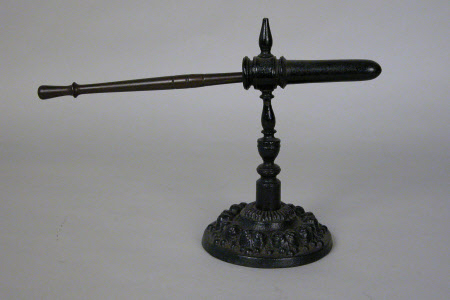Goffering iron
Category
Metalwork
Date
c. 1800 - c. 1900
Materials
Iron and steel
Measurements
270 x 370 mm; 150 mm (Diameter)
Order this imageCollection
Rufford Old Hall, Lancashire
NT 784156
Caption
Strangely shaped metal objects like this would have been used in the hot and steamy environment of the laundry from the 17th century onwards. While most irons removed creases from clothing, it was also important that ruffles and flounces were not flattened. The goffering iron was developed to keep the curl in frills and the pleats on collars, cuffs and bonnets. The hollow tube of the iron is set horizontally on a stand, allowing a red-hot metal rod or poker to be placed inside. The frills could be curled around the heated tube, like a hair curler. These irons were sometimes known as ‘tally’ irons, since they were believed to have been introduced from Italy. This example can be found at Rufford Old Hall, which exhibits five centuries of history. Only the Great Hall survives from the original Tudor structure and the old service wings have been replaced by later extensions, but there was once a laundry and a drying room. Rufford is also home to the Philip Ashcroft collection of household and rural objects, illustrating south-west Lancashire folk life.
Summary
Iron goffering iron stand with moulded base and steel goffering iron.
Full description
Delicate ruffles and frills on garments could not be pressed into shape with a regular flatiron, so a range of irons of different shapes and sizes were used in the laundry. These included ribbed crimping irons but also goffering or ‘tally’ irons, which helped shape ruffles and flounces in starched linen. ‘Tally’ iron is a corruption of ‘Italian iron’, as these were probably introduced from Italy in the early seventeenth century. In Mrs Beeton’s Book of Household Management (1861), she describes the Italian iron as ‘a hollow tube, smooth on the outside, and raised on a slender pedestal with a footstalk. Into the hollow cylinder a red-hot iron is pushed, which heats it; and the smooth outside of the latter is used, on which articles such as frills and plaited articles are drawn.’ They were recommended for use on frilled cuffs, collars and trimmings. In her novel Shirley (1849), Charlotte Brontë describes the ‘Italian-ironed double frills’ on a baby’s bonnet.
